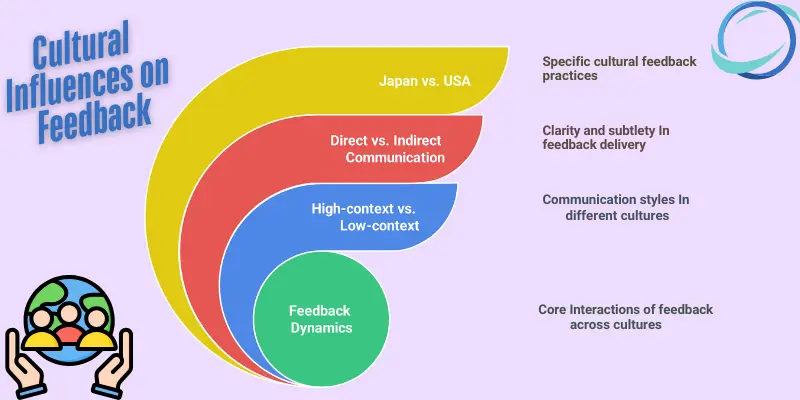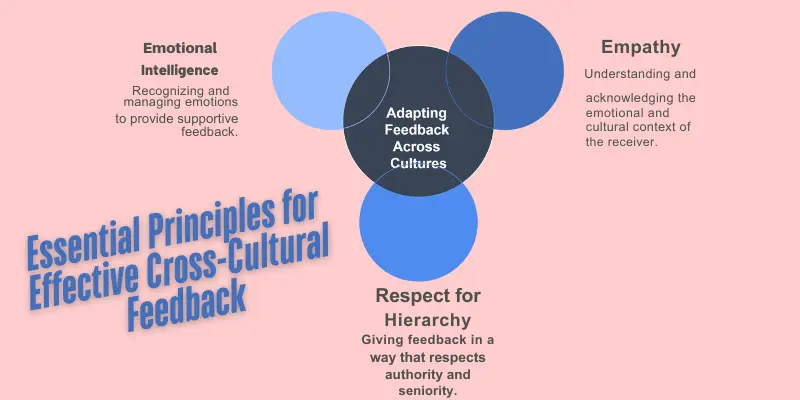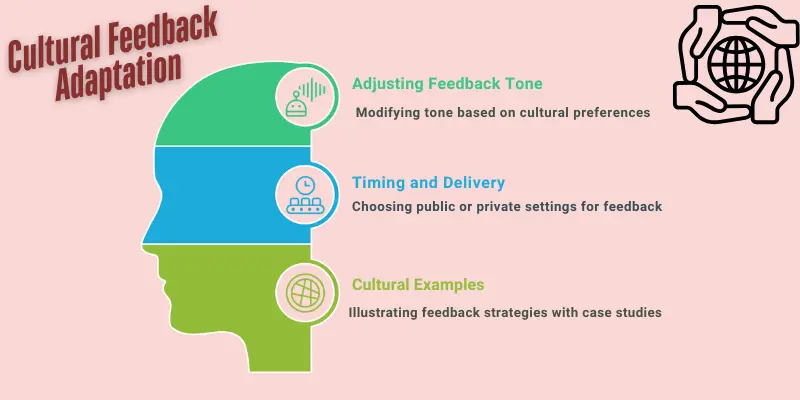Practical Feedback Strategies Across Cultures: What Works in Global Teams
Published: 16/04/2025
Here’s a situation you might be familiar with: Sarah, a manager based in the United States, is leading a virtual meeting with her global team. During the meeting, she provides direct feedback to her team member, Hiroshi from Japan. She tells him that his presentation “wasn’t clear enough” and that he needs to improve the structure. Hiroshi nods politely, but later, Sarah notices that he seems withdrawn and less engaged during team discussions. Confused, Sarah starts to wonder: Did her feedback miss the mark?
This is a challenge many managers face when working with teams from diverse cultural backgrounds. Feedback isn’t one-size-fits-all; what works in one culture can easily be misinterpreted in another. For Sarah, her well-intended, direct feedback may have felt harsh or uncomfortable for Hiroshi, whose culture values subtlety and respect for harmony.
In this post, we’ll explore practical feedback strategies that work across cultures, helping you navigate these differences with ease. You’ll learn how to adjust your tone, timing, and delivery to ensure your feedback is not only understood but also embraced, no matter where your team members are from.
By the end of this article, you’ll walk away with actionable tips that will help you tailor your feedback for maximum impact, improve team communication, and strengthen collaboration across borders. Ready to make your feedback more effective and culturally sensitive? Let’s dive in!
How Cultural Differences Impact Feedback: What You Need to Know
Cultural norms and values shape how feedback is delivered and received across different global teams. Understanding these differences can help improve communication, trust, and productivity. Here’s a quick look at how cultural context influences feedback:

High-context vs. Low-context Cultures
High-context cultures (e.g., Japan, Korea) rely on indirect communication and non-verbal cues. Feedback may be more subtle and often delivered in a more nuanced way to maintain harmony and avoid embarrassment.
Low-context cultures (e.g., USA, Germany) prefer direct and explicit communication. Feedback tends to be more straightforward, focusing on facts and clarity.
Direct vs. Indirect Communication
Direct communication involves clear, unambiguous feedback. It’s common in cultures like the US, where people value transparency and efficiency.
Indirect communication is more common in cultures like Japan or India, where maintaining face and social harmony is important. Feedback may be delivered in a way that avoids confrontation or shame.
Example: Japan vs. USA
- In Japan, feedback is often given in private to avoid embarrassing the person in front of others. The tone is usually more respectful, and the focus is on maintaining relationships.
- In contrast, in the USA, feedback can be given more publicly, with a focus on clarity and improvement. People in the US often appreciate directness and transparency, as it helps them understand exactly what needs to change.
Essential Principles for Adapting Feedback Across Different Cultures
When giving feedback across cultures, it’s important to consider key principles that can ensure the feedback is respectful, effective, and meaningful. Here are some essential principles for adapting feedback:

- Empathy
- Understand and acknowledge the emotional and cultural context of the person receiving feedback. Empathy allows for a more thoughtful delivery, ensuring that feedback doesn’t come off as harsh or insensitive.
- Understand and acknowledge the emotional and cultural context of the person receiving feedback. Empathy allows for a more thoughtful delivery, ensuring that feedback doesn’t come off as harsh or insensitive.
- Respect for Hierarchy
- In many cultures, particularly in Asia and the Middle East, hierarchy plays a significant role in communication. Feedback should be given in a way that respects authority and seniority, often in a more formal or private manner.
- In many cultures, particularly in Asia and the Middle East, hierarchy plays a significant role in communication. Feedback should be given in a way that respects authority and seniority, often in a more formal or private manner.
- Emotional Intelligence
- The ability to recognize and manage your own emotions, and the emotions of others, is critical in cross-cultural feedback. Being aware of how feedback may affect someone emotionally can help you adjust your approach to be more supportive and constructive.
- The ability to recognize and manage your own emotions, and the emotions of others, is critical in cross-cultural feedback. Being aware of how feedback may affect someone emotionally can help you adjust your approach to be more supportive and constructive.
Tips for Adapting Feedback
- Adjust Tone and Language
- In Western cultures (e.g., US, UK), feedback can often be more direct and even blunt. In contrast, in many Asian cultures (e.g., Japan, China), the tone should be softer, and feedback might be delivered with more care to avoid losing face.
- Always tailor your feedback structure based on the cultural expectations of the person receiving it. For example, start with positive reinforcement before introducing areas for improvement if the culture values maintaining harmony.
- In Western cultures (e.g., US, UK), feedback can often be more direct and even blunt. In contrast, in many Asian cultures (e.g., Japan, China), the tone should be softer, and feedback might be delivered with more care to avoid losing face.
- Private vs. Public Feedback
- In cultures that emphasize respect for hierarchy (e.g., Japan, South Korea), it’s often best to give feedback in private. In contrast, some Western cultures (e.g., the US, Canada) may allow for public feedback, especially when it’s constructive and seen as a team-building opportunity.
- In cultures that emphasize respect for hierarchy (e.g., Japan, South Korea), it’s often best to give feedback in private. In contrast, some Western cultures (e.g., the US, Canada) may allow for public feedback, especially when it’s constructive and seen as a team-building opportunity.
Example: Adapting Feedback for a Diverse Team
- Western Culture (e.g., USA): A leader might give direct feedback like, “Your presentation was unclear. Let’s improve the structure for the next one.”
- Asian Culture (e.g., Japan): A leader may give more nuanced feedback, such as, “Your presentation had some strong points, but perhaps we could refine the structure a bit more for greater clarity next time.”
These principles ensure that feedback is not only effective but also culturally appropriate, strengthening relationships and improving team performance across global teams.
How to Tailor Feedback to Different Cultures for Maximum Impact
Adapting feedback to different cultural contexts can significantly improve communication and team performance. Here’s a step-by-step guide on how to tailor feedback for various cultures:

- Adjust Feedback Tone
- Positive Reinforcement vs. Corrective Feedback: In cultures that prioritize harmony (e.g., Japan, Korea), start with positive reinforcement before offering areas for improvement. This helps maintain face and reduces the risk of the recipient feeling embarrassed or defensive.
- In more direct cultures (e.g., USA, Germany), corrective feedback can be given upfront, as it’s often valued for its clarity and honesty. However, even in these cultures, it’s important to deliver feedback respectfully.
- Positive Reinforcement vs. Corrective Feedback: In cultures that prioritize harmony (e.g., Japan, Korea), start with positive reinforcement before offering areas for improvement. This helps maintain face and reduces the risk of the recipient feeling embarrassed or defensive.
- Timing and Delivery
- Public vs. Private Feedback: Cultures such as in the Middle East or Japan value privacy when delivering feedback, especially if the feedback involves criticism. It’s best to have private one-on-one conversations in these cultures to avoid losing face or causing embarrassment.
- Public vs. Private Feedback: Cultures such as in the Middle East or Japan value privacy when delivering feedback, especially if the feedback involves criticism. It’s best to have private one-on-one conversations in these cultures to avoid losing face or causing embarrassment.
In North America or Northern Europe, public feedback is more common and can be a valuable tool for encouraging team collaboration. However, it’s still important to be mindful of the tone, even in a public setting.
Examples
- Case Study: In a global organization with teams in both the US and Japan, a manager adjusted her feedback approach by starting with positive comments and a soft approach in Japan. She focused on the team’s strengths and then suggested areas of improvement gently.
- In contrast, when working with the US team, she directly addressed the areas of improvement, providing clear and actionable steps. This adjustment improved team morale and communication, as team members felt more comfortable and motivated to improve according to their cultural expectations.
By following these steps and understanding the cultural nuances, feedback becomes more impactful and helps foster stronger, more productive global teams.
Overcoming Challenges in Cross-Cultural Feedback: Solutions for Global Teams
Giving feedback across cultures presents unique challenges that can lead to misunderstandings if not handled carefully. Here are some common mistakes and how to avoid them:
- Assuming Cultural Similarities
- Mistake: Assuming that people from different cultures will respond to feedback the same way can lead to miscommunication. For example, what works in the US may not work in Japan, where indirect feedback is preferred.
- Solution: Always recognize and research cultural differences before giving feedback. Don’t assume that one approach works universally.
- Mistake: Assuming that people from different cultures will respond to feedback the same way can lead to miscommunication. For example, what works in the US may not work in Japan, where indirect feedback is preferred.
- Using Overly Blunt Feedback
- Mistake: In cultures that value politeness and face-saving (e.g., Japan, India), direct or blunt feedback can be seen as rude or disrespectful.
- Solution: Adjust your tone and approach based on the cultural context. For cultures that prefer indirect communication, soften your language and use more nuanced feedback.
- Mistake: In cultures that value politeness and face-saving (e.g., Japan, India), direct or blunt feedback can be seen as rude or disrespectful.
- Neglecting to Consider Individual Preferences
- Mistake: Failing to take into account the personal preferences of the individual receiving feedback can result in disengagement or frustration. Not all individuals from the same culture prefer the same feedback style.
- Solution: Whenever possible, ask for feedback preferences upfront. This shows respect for the individual’s needs and can help you deliver feedback in a more effective way.
- Mistake: Failing to take into account the personal preferences of the individual receiving feedback can result in disengagement or frustration. Not all individuals from the same culture prefer the same feedback style.
Examples of Misunderstandings
- Assumption Mistake: A manager from the US gives direct, corrective feedback to a team member from Japan in front of the whole team. This approach, which is typical in the US, could cause embarrassment or discomfort in the Japanese team member, potentially damaging the relationship.
- Solution: The manager could have delivered the feedback privately and framed it more gently, respecting cultural norms of indirect communication.
- Solution: The manager could have delivered the feedback privately and framed it more gently, respecting cultural norms of indirect communication.
- Blunt Feedback Mistake: In an international team, a European team leader provides blunt feedback to an employee from South Korea, which comes off as too harsh. This leads to tension within the team, as the employee feels humiliated.
- Solution: The leader could have given the feedback in a more respectful, private manner, acknowledging the employee’s efforts before discussing areas of improvement.
- Solution: The leader could have given the feedback in a more respectful, private manner, acknowledging the employee’s efforts before discussing areas of improvement.
Tips for Overcoming These Challenges
- Research Cultural Differences: Take the time to understand the cultural norms and expectations around feedback for each team member. Use resources or consult colleagues who have experience working in those cultures.
- Ask for Feedback Preferences: Ask team members how they prefer to receive feedback. Some might want direct, actionable feedback, while others may appreciate a more supportive and gentle approach.
- Be Culturally Sensitive: Always consider the broader cultural context when giving feedback. What may seem like constructive criticism to you could be perceived as a personal attack in another culture.
By acknowledging these challenges and adjusting your feedback style accordingly, you can avoid misunderstandings and help your team communicate more effectively across cultures.
Critical Mistakes to Avoid When Giving Feedback Across Cultures
Giving feedback across cultures requires attention to detail and cultural sensitivity. Here are some critical mistakes to avoid when delivering feedback:
- Ignoring Cultural Context
- Mistake: Assuming that feedback preferences are universal can lead to miscommunication and resentment. For example, giving direct feedback in cultures that value indirect communication may come across as too harsh or disrespectful.
- Solution: Always research and understand the cultural context before giving feedback. Consider how feedback is generally perceived and delivered in that culture.
- Mistake: Assuming that feedback preferences are universal can lead to miscommunication and resentment. For example, giving direct feedback in cultures that value indirect communication may come across as too harsh or disrespectful.
- Not Adjusting the Tone of Feedback
- Mistake: Using the same tone for all cultures can be detrimental. For instance, a tone that’s considered motivating and clear in the US may be perceived as aggressive or rude in Japan.
- Solution: Adjust your tone based on the cultural expectations. In cultures that prioritize respect and hierarchy, a softer and more respectful tone is often necessary.
- Mistake: Using the same tone for all cultures can be detrimental. For instance, a tone that’s considered motivating and clear in the US may be perceived as aggressive or rude in Japan.
- Providing Feedback in a Public Setting When Privacy is Preferred
- Mistake: Giving feedback in front of others, especially when it’s critical, can lead to embarrassment in cultures that value privacy, such as in many Asian and Middle Eastern cultures.
- Solution: In these cultures, it’s better to provide feedback privately, ensuring that the person’s dignity is maintained.
- Mistake: Giving feedback in front of others, especially when it’s critical, can lead to embarrassment in cultures that value privacy, such as in many Asian and Middle Eastern cultures.
Examples of Critical Mistakes
- Bad Example 1 – Ignoring Cultural Context:
A manager from the US gives direct, blunt feedback to an employee from Japan during a team meeting. The feedback focuses on specific mistakes, and the employee feels uncomfortable and embarrassed.
- Improvement: The manager could have given the feedback privately and started with positive comments before gently pointing out areas for improvement, adhering to the Japanese culture of indirect feedback.
- Improvement: The manager could have given the feedback privately and started with positive comments before gently pointing out areas for improvement, adhering to the Japanese culture of indirect feedback.
- Bad Example 2 – Not Adjusting the Tone:
A European team leader uses a direct, firm tone when providing feedback to a team member from India. The employee feels disrespected, as they are not used to receiving such straightforward criticism.
- Improvement: The leader could have softened the tone, using more supportive language and showing empathy to align with Indian cultural values of respect and harmony.
- Improvement: The leader could have softened the tone, using more supportive language and showing empathy to align with Indian cultural values of respect and harmony.
- Bad Example 3 – Public Feedback in a Private Culture:
A manager from North America gives critical feedback publicly in a meeting with an employee from South Korea. This approach makes the employee feel uncomfortable and embarrassed, as South Korean culture tends to prioritize private and respectful communication.
- Improvement: The manager should have given the feedback privately, ensuring the employee felt respected and their dignity maintained.
- Improvement: The manager should have given the feedback privately, ensuring the employee felt respected and their dignity maintained.
By being mindful of these common mistakes and making necessary adjustments, feedback can be delivered in a way that’s culturally sensitive and effective. Avoiding these critical errors can help build stronger relationships and improve communication across diverse teams.
Here are some quick, actionable tips to keep in mind when giving feedback in a multicultural team:
Cultural Awareness is Crucial
Understanding cultural differences and how they affect feedback can make all the difference. What works in one culture might not be effective in another. Always educate yourself about the cultural norms of your team members to provide feedback that’s well-received.
Tailor Feedback Methods Based on Cultural Norms
Different cultures have different expectations when it comes to feedback. Some cultures value direct and clear feedback, while others prefer a more indirect approach. Be flexible and adjust your feedback methods according to the cultural norms of the person you’re addressing.
Avoid Making Assumptions About How Feedback Will Be Received
Just because a certain style of feedback works with one person doesn’t mean it will work with others. Avoid assuming that your feedback approach will be effective across the board. Always ask your team members about their preferences and be open to adapting your style.
Use Empathy and Emotional Intelligence
Feedback is more effective when it’s delivered with empathy. Try to understand how the recipient might feel and adjust your tone accordingly. Emotional intelligence allows you to gauge the situation and respond appropriately, fostering a more positive environment for growth.
Practice Cultural Sensitivity in Global Teams
When working with international teams, it’s important to be aware of cultural sensitivities. What may seem like constructive feedback in one culture could be seen as rude or inappropriate in another. Always be respectful of cultural differences and strive for an inclusive and supportive environment.
By applying these quick tips, you’ll be able to provide feedback that is not only effective but also culturally respectful and considerate, leading to stronger relationships and better team dynamics.
Wrap-Up: Transforming Your Feedback Approach for Global Teams:
In today’s globalized workplace, adapting your feedback strategies to cultural differences is more important than ever. Understanding how cultural contexts shape the way feedback is delivered and received can help you avoid misunderstandings and foster better communication within your team. We’ve covered key principles like adjusting your feedback tone, timing, and delivery to ensure it resonates with team members from different backgrounds. Whether you’re working with teams in North America, Europe, or Asia, these strategies can make a significant difference in how feedback is perceived and acted upon.
It may seem daunting at first, but applying these small adjustments to your feedback approach can lead to improved communication, stronger relationships, and enhanced team performance. Remember, the power of feedback lies in how it’s given—and with a little cultural awareness, you can make sure your feedback is both effective and well-received. So, don’t wait—start applying these strategies today and see the positive impact they’ll have on your team’s collaboration and success.
Have you encountered challenges when giving feedback to a diverse team? Share your experiences in the comments below—we’d love to hear your thoughts! For more practical tips on managing cross-cultural communication, subscribe to our blog.
Got Questions? Let’s Clarify Feedback Strategies for Global Teams
Frame it as learning: “Sir/Ma’am, I’d appreciate your guidance to improve.” Avoid putting seniors on the spot.
Use async tools like Loom (video messages) or brief Slack voice notes. Set clear response expectations: “No need to reply today—by Friday is fine!”
Use simple words, avoid idioms (“drop the ball”), and check understanding: “Does this make sense? Want to discuss further?”
Different cultures communicate differently. Some prefer direct criticism (e.g., Germany), while others use hints (e.g., Japan). Misunderstandings happen easily.
Ask! Try: “How do you prefer to receive feedback?” If they pause or seem uncomfortable, switch to indirect phrases like “What if we tried…?”
Highlight the group, not individuals: “The team’s collaboration made this succeed!” Individual praise can cause discomfort.
Silence often means deep consideration, not disagreement. Pause 5+ seconds—they may just be formulating a careful response.
Acknowledge both: “I know we value directness here, but let’s focus on solutions, not just problems.” Balance honesty with respect.
Use the “Sandwich Method” (praise-critique-praise) until you learn local norms. Example: “Your report was thorough! Adding more data here could strengthen it. Great start overall!”
In conflict-averse cultures, try 1-on-1 chats instead of group settings. Ask open questions: “How would you approach this?” to spark dialogue without pressure.

- Be Respectful
- Stay Relevant
- Stay Positive
- True Feedback
- Encourage Discussion
- Avoid Spamming
- No Fake News
- Don't Copy-Paste
- No Personal Attacks

- Be Respectful
- Stay Relevant
- Stay Positive
- True Feedback
- Encourage Discussion
- Avoid Spamming
- No Fake News
- Don't Copy-Paste
- No Personal Attacks





